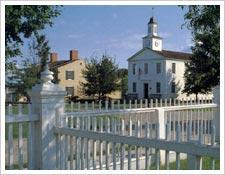
In reading the last post about favorite places, I thought of how long it has been since I have gone to a magical spot just for me. I love historic places, and they are great food for the muse.
I’ve been to a few places in the past that I loved. Here is one: The Genesee Country Village and Museum. It is a living history museum in Mumford, N.Y., just 20 miles from Rochester, and its focus is the 19th century.
url: http://www.gcv.org/index.shtml
More than a historic village, it has activities, classes, scheduled events, gardens, a nature center, an art gallery, and a carriage museum. But in my particular experience, the stand-out event was the day I attended a reenactment of the Battle of Gettysburg.
The Union troops mustered in the town square. It was a hot July weekend, and I remember with a little of the thrill I felt then when the sky rumbled overhead. The men cheered–and soon we were standing in a pouring torrent.
I took shelter on the front porch of one of the houses with other visitors and waited for the event to start. We heard the approach of the confederate troops from the edge of town and the distant sount of musket fire…the battle grew closer, and then the union troops were retreating through the town in front of us, in the pouring rain and the fog of black powder smoke, the soldiers nothing but hazy figures, running, reloading, firing, calling out, falling–and of course as they do in reinactments, getting up and running again–but I ignored that part. It felt eerily as though I were really there in Gettysburg.
It did not pour on any of the days of battle (July 1-4, 1863) but it was overcast with some thunder and light rain. But something about the scene that day seemed so utterly real to me. It is something the hazy photographs I took do not quite bring back, but the memory of the feeling I had is more than enough.
Has anyone else had such a transporting moment? I wonder how many of us are historical site buffs who read and write Regencies? I’d be willing to bet most of us are…
Laurie







